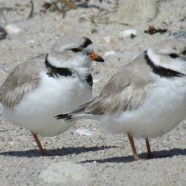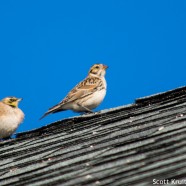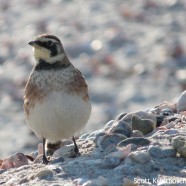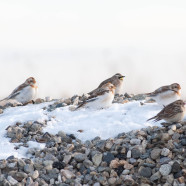Change in Seasons Brings Plenty of Birds
Winter Bird Forecast #7 is brought to you by Audubon Connecticut in partnership with the Roger Tory Peterson Institute of Natural History. It is hard to believe that for some birds spring is already here. Waterfowl and diving birds like loons and grebes are already heading north and we are starting to get some northbound migrant shorebirds, including a Black-bellied Plover seen in Stratford last week. Brant geese are piling into Long Island Sound with rapidly increasing numbers. Within a few short weeks some of our nesting shorebirds, such as Piping Plover and American Oystercatcher, will be...
Read MoreLapland Longspur (Calcarius lapponicus)
I recently took the photo of the flock of birds, including mostly Snow Buntings and Horned Larks, mostly for a record-type shot of a Lapland Longspur (Calcarius lapponicus) mixed in. They were enjoying some exposed grass to feed on with snow still covering so much of the earth. However, when looking at the photo I noticed I actually had two Longspurs, with a second mixed in behind it. They are in the right center of the shot. Thankfully I was able to photograph one of them a few days later while sitting on this roof with a Horned Lark sitting behind it, the heat haze from the strong sun ever...
Read MoreHorned Lark (Eremophila alpestris)
The Horned Lark (Eremophila alpestris) is a species of open areas – the tundra, grasslands, fields, beaches and dunes and even the desert. Unsurprisingly they feed on the ground on insects and seeds and often take advantage of human activity disturbing areas such as mowed airports or piles of plowed earth or snow that expose more food. When it comes to the winter you will find them wherever it is the most bare. You can frequently spot them with Snow Buntings and, more rarely, the Lapland Longspur. They are also another species decreasing across much of their range and are listed as...
Read MoreIdentify these three winter species
Can you identify all the wintering birds in this photo? There are five individuals of three species here. They do enjoy hanging out with one another and this year it seems plenty of people have been lucky enough to spot them together in various parts of the northeast. They all enjoy open areas like grasslands, farms, beaches, roadsides and fields. The answers will be listed after this photo so don’t cheat! Do you have them all? If not look away now! The birds are, from left to right, a Snow Bunting (Plectrophenax nivalis), another Snow Bunting with a Horned Lark (Eremophila alpestris)...
Read More







